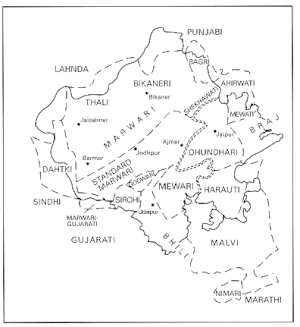| Rājasthānī | |
|---|---|
| राजस्थानी રાજસ્થાની | |
| Ethnicity | Rajasthanis |
| Geographic distribution | Rajasthan, Malwa (MP) |
Native speakers | 16 million (2011 census)[1] |
| Linguistic classification | Indo-European |
Early form | |
| ISO 639-2 / 5 | raj |
| ISO 639-3 | raj |
| Glottolog | raja1256 |
 | |
Rajasthani languages are a group of Indo-Aryan languages and dialects spoken primarily in the state of Rajasthan and adjacent areas of Haryana, Gujarat and Madhya Pradesh in India. There are also speakers in the Pakistani provinces of Punjab and Sindh. Rajasthani is also spoken to a lesser extent in Nepal where it is spoken by 25,394 people according to the 2011 Census of Nepal.[3]
The term Rajasthani is also used to refer to a literary language mostly based on Marwari.[4]: 441
Geographical distribution
Most of the Rajasthani languages are chiefly spoken in the state of Rajasthan but are also spoken in Gujarat, Haryana and Punjab. Rajasthani languages are also spoken in the Bahawalpur and Multan sectors of the Pakistani provinces of Punjab and Tharparkar district of Sindh. It merges with Riasti and Saraiki in Bahawalpur and Multan areas, respectively. Many linguists (Shackle, 1976 and Gusain, 2000) agree that it shares many phonological (implosives), morphological (future tense marker and negation) and syntactic features with Riasti and Saraiki. A distribution of the geographical area can be found in 'Linguistic Survey of India' by George A. Grierson.

Speakers
Standard Rajasthani or Standard Marwari, a version of Rajasthani, the common lingua franca of Rajasthani people and is spoken by over 25 million people (2011) in different parts of Rajasthan.[5] It has to be taken into consideration, however, that some speakers of Standard Marwari are conflated with Hindi speakers in the census. Marwari, the most spoken Rajasthani language with approximately 8 million speakers[5] situated in the historic Marwar region of western Rajasthan. Total number of people speaking Rajasthani or it's various sub languages and dialects and verities are around 60 Million which are mainly living in Rajasthan and it's neighbouring states.
Classification
The Rajasthani languages belong to the Western Indo-Aryan language family. However, they are controversially conflated with the Hindi languages of the Central-Zone in the Indian national census, among other places. The main Rajasthani subgroups are:[6]

- Rajasthani
- Western Rajasthani
- Bhilli-Banjara Adivasi
- Northern Rajasthani
- Eastern Rajasthani[8]
Languages and dialects
| Language[10] | ISO 639-3 | Scripts | No. of speakers[11] | Geographical distribution |
|---|---|---|---|---|
| Rajasthani | raj | Devanagari; previously Mandya;
Mahajani |
25,810,000[12] | Western and Northern part of Rajasthan |
| Marwari | mwr | Devanagari | 7,832,000 | Marwar region of Western Rajasthan |
| Malvi | mup | Devanagari | 5,213,000 | Malva region of Madhya Pradesh radesh and Rajasthan |
| Mewari | mtr | Devanagari | 4,212,000 | Mewar region of Rajasthan |
| Wagdi | wbr | Devanagari | 3,394,000 | Dungarpur and Banswara districts of Southern Rajasthan |
| Lambadi | lmn | 3,277,000 | Banjaras of Maharashtra, Karnataka and Andhra Pradesh | |
| Hadauti | hoj | Devanagari | 2,944,000 | Hadoti region of southeastern Rajasthan |
| Nimadi | noe | Devanagari | 2,309,000 | Nimar region of west-central India within the state of Madhya Pradesh |
| Bagri | bgq | Devanagari, Gurmukhi | 1,657,000 | Nohar-Bhadra,Anupgarh, Hanumagarh , Northern tehsils of Bikaner and Sri Ganganagar district of Rajasthan , Sirsa and Fatehabad district Hisar,Bhiwani,Charkhi dadridistrict of Haryana, Fazilka district of Punjab |
| Ahirani | ahr | Devanagari | 1,636,000 | Khandesh region of north-west Maharashtra and also in Gujarat |
| Dhundhari | dhd | Devanagari | 1,476,000 | Dhundhar region of northeastern Rajasthan Jaipur, Sawai Madhopur, Dausa, Tonk and some parts of Sikar and karauli district |
| Gujari | gju | Takri, Pasto-Arabic, Devanagari | 1,228,000 | Northern parts of India and Pakistan as well as in Afghanistan |
| Dhatki | mki | Devanagri, Mahajani, Arabic | 210,000 | Pakistan and India (Jaisalmer and Barmer districts of Rajasthan and Tharparkar and Umerkot districts of Sindh) |
| Shekhawati | swv | Devanagari | 3,000,000 | the Shekhawati region of Rajasthan which comprises the Churu, Jhunjhunu , Neem-Ka-Thana and Sikar districts. |
| Godwari | gdx | Devanagari, Gujarati | 3,000,000 | Pali and Sirohi districts of Rajasthan and Banaskantha district of Gujarat |
| Sahariya | Devanagari |
See also
References
- ↑ Rājasthānī at Ethnologue (26th ed., 2023)

Bagri at Ethnologue (26th ed., 2023)
Gade Lohar at Ethnologue (26th ed., 2023)
Gujari at Ethnologue (26th ed., 2023)
Dhatki at Ethnologue (26th ed., 2023)
Malvi at Ethnologue (26th ed., 2023)
Wagdi at Ethnologue (26th ed., 2023)
(Additional references under 'Language codes' in the information box) - ↑ Ernst Kausen, 2006. Die Klassifikation der indogermanischen Sprachen (Microsoft Word, 133 KB)
- ↑ Central Bureau of Statistics (2014). Population monograph of Nepal (PDF) (Report). Vol. II. Government of Nepal.
- ↑ Masica, Colin (1991), The Indo-Aryan Languages, Cambridge: Cambridge University Press, ISBN 978-0-521-29944-2.
- 1 2 3 2011 Census data censusindia.gov.in
- ↑ "Ethnologue.com: Ethnologue report for Rajasthani". Retrieved 9 July 2023.
- ↑ "Pakistan & Afghanistan - Carte linguistique / Linguistic map".
- ↑ Gold, Ann Grodzins. A Carnival of Parting: The Tales of King Bharthari and King Gopi Chand as Sung and Told by Madhu Natisar Nath of Ghatiyali, Rajasthan. Berkeley: University of California Press, c1992 1992. http://ark.cdlib.org/ark:/13030/ft3g500573/
- ↑ "pg no 293,296".
- ↑ "Browse by Language Family". Ethnologue. Archived from the original on 4 January 2012. Retrieved 20 December 2019.
- ↑
- ↑ "Angika". Archived from the original on 24 March 2016. Retrieved 17 March 2016.
External links
|}
